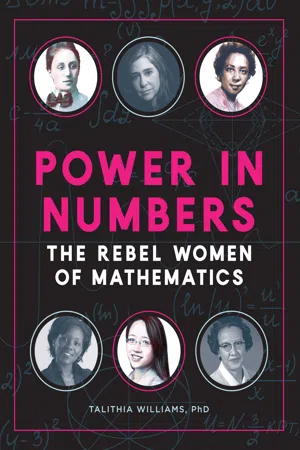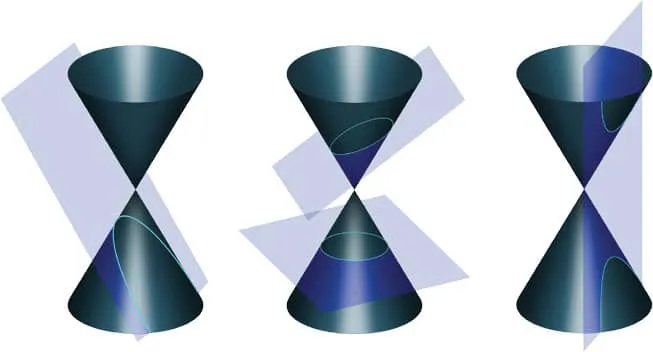
This book is available to read until 23rd April, 2026
- 288 pages
- English
- ePUB (mobile friendly)
- Available on iOS & Android
eBook - ePub
Available until 23 Apr |Learn more
About this book
From rocket scientists to code breakers, discover the incredibly inspiring stories of more than 30 women who fought through the obstacles, shattered the stereotypes, and embraced their STEM passions.
Prepare to be inspired. With more than 200 photos and original interviews with several of the amazing women covered, Power in Numbers: The Rebel Women of Mathematics is a full-color volume that takes aim at the forgotten influence of women on the development of mathematics over the last two millennia.
Each biography reveals the amazing life of a different female mathematician, from her childhood and early influences, to the obstacles she faced and the great achievements she made in spite of them. Learn how:
May their stories empower the next generation of STEM rebels to continue advancing mathematical theory, bringing awareness to the field, and increasing our Power in Numbers.
Prepare to be inspired. With more than 200 photos and original interviews with several of the amazing women covered, Power in Numbers: The Rebel Women of Mathematics is a full-color volume that takes aim at the forgotten influence of women on the development of mathematics over the last two millennia.
Each biography reveals the amazing life of a different female mathematician, from her childhood and early influences, to the obstacles she faced and the great achievements she made in spite of them. Learn how:
- After her father terminated her math lessons, Sofia Kovalevskaya snuck algebra books into her bed to read at night.
- Emmy Noether became an invaluable resource to Albert Einstein while she was in the Navy.
- Native American rocket scientist Mary Golda Ross developed designs for fighter jets and missiles in a top-secret unit.
- Katherine Johnson’s life-or-death calculations at NASA meant that astronauts such as Alan Shepard and John Glenn made it home alive.
- Shakuntala Devi multiplied massive numbers in her head so her family could eat at night.
- Pamela Harris proved her school counselors wrong when they told her she would only succeed as a bilinguial secretary.
- Carla Cotwright-Williams began her life in the dangerous streets of South-Central Los Angeles before skyrocketing to a powerful career with the Department of Defense in Washington DC.
May their stories empower the next generation of STEM rebels to continue advancing mathematical theory, bringing awareness to the field, and increasing our Power in Numbers.
Frequently asked questions
Yes, you can cancel anytime from the Subscription tab in your account settings on the Perlego website. Your subscription will stay active until the end of your current billing period. Learn how to cancel your subscription.
At the moment all of our mobile-responsive ePub books are available to download via the app. Most of our PDFs are also available to download and we're working on making the final remaining ones downloadable now. Learn more here.
Perlego offers two plans: Essential and Complete
- Essential is ideal for learners and professionals who enjoy exploring a wide range of subjects. Access the Essential Library with 800,000+ trusted titles and best-sellers across business, personal growth, and the humanities. Includes unlimited reading time and Standard Read Aloud voice.
- Complete: Perfect for advanced learners and researchers needing full, unrestricted access. Unlock 1.4M+ books across hundreds of subjects, including academic and specialized titles. The Complete Plan also includes advanced features like Premium Read Aloud and Research Assistant.
We are an online textbook subscription service, where you can get access to an entire online library for less than the price of a single book per month. With over 1 million books across 1000+ topics, we’ve got you covered! Learn more here.
Look out for the read-aloud symbol on your next book to see if you can listen to it. The read-aloud tool reads text aloud for you, highlighting the text as it is being read. You can pause it, speed it up and slow it down. Learn more here.
Yes! You can use the Perlego app on both iOS or Android devices to read anytime, anywhere — even offline. Perfect for commutes or when you’re on the go.
Please note we cannot support devices running on iOS 13 and Android 7 or earlier. Learn more about using the app.
Please note we cannot support devices running on iOS 13 and Android 7 or earlier. Learn more about using the app.
Yes, you can access Power in Numbers by Talithia Williams in PDF and/or ePUB format, as well as other popular books in Mathematics & Social Science Biographies. We have over one million books available in our catalogue for you to explore.
Information
PART 1
The Pioneers

Emmy Noether
The field of mathematics is not known for being especially friendly or appealing to women throughout history, but with the explosion of sophisticated technology in the twentieth century and beyond, many female mathematicians are making essential contributions to all kinds of human endeavors, from bioinformatics to spaceflight. The rise of universities in Ancient Greece laid the groundwork for modern university education and eventually for the breakthroughs of today, with teachers presenting subjects like philosophy and rhetoric alongside mathematics and astronomy. One such professor was Theon of Alexandria (ca. 335–ca. 405), who taught mathematics at the local university and wrote commentaries on some of the greatest scientific works of Ancient Greece, including Euclid’s Elements and Ptolemy’s Almagest. Theon passed his passion for learning to his daughter Hypatia (d. 415), who helped him write those commentaries and whose reputation would surpass his own.
Hypatia studied philosophy, astronomy, and mathematics in Athens, Greece, before she became head of the Neoplatonist school in Alexandria around the turn of the fifth century. She was a particularly skilled speaker, and many people from other cities flocked to the intellectual center of Egypt to hear her lectures. Within mathematics, she is best known for her work on Apollonius’s treatise on conic sections, which divided cones into different parts using flat geometric planes and introduced the concepts of the parabola, hyperbola, and ellipse.
Like too many women in this book, Hypatia paid a heavy price for her pursuit of knowledge, though her story is the most gruesome. As recounted in the 2009 film Agora (and countless plays and works of fiction throughout history), the Bishop of Alexandria spread virulent rumors about her, and one day in 415, she was attacked by a Christian mob, stripped, stabbed to death with broken pottery, and dragged through the streets.

When a double cone is intersected by a plane, the parabola (left), ellipse (center), and hyperbola (right) are created.

An 1865 engraving depicting the death of Hypatia.
It is almost certain that other female mathematicians quietly carried on her legacy through the European Medieval period, the Chinese Song Dynasty, the Islamic Golden Age, and the Renaissance, but there is little record of female achievements in mathematics prior to the publication of French mathematician and philosopher René Descartes’s monumental treatise Discourse on the Method—original source of the famous expression cogito ergo sum (“I think, therefore I am”)—in 1637. Just four years later, a French woman of obscure origins named Marie Crous published a study on the decimal numerical system, which introduced the decimal point that is central to our modern notation. A hundred years after that, Frenchwoman Émilie du Châtelet (1706–1749) published Institutions de Physique (Foundations of Physics), which explained and analyzed the cutting-edge mathematical ideas of Gottfried Leibniz, who later became co-discoverer of calculus, with Sir Isaac Newton. Naturally rumors spread that Châtelet was merely rehashing the lessons of her tutor Samuel Koenig, but in the end several prominent scientists came to her defense, and she was elected to the Academy of Sciences of the Institute of Bologna in 1746. Two years later, the Italian mathematician Maria Gaetana Agnesi (1718–1799) published one of the first and most complete textbooks on finite and infinitesimal analysis: Instituzioni Analitiche (Analytical Institutions). The book was widely translated, and in 1750 Pope Benedict XIV appointed her to the chair of mathematics and natural philosophy at the University of Bologna, making her the first woman in history ever to be appointed to a mathematics university professorship.
Jumping ahead to 1890, we arrive in Cambridge, England, where Philippa Fawcett (1868–1948) has just become the first woman to earn a top score on the annual Mathematical Tripos exam (beating out all her male classmates), and students Isabel Maddison (1869–1950) and Grace Chisholm (1868–1944) are studying calculus and linear algebra at Girton College. Two years later, Maddison and Chisholm passed the Tripos exam, earning the equivalent of first-class degrees in mathematics from Cambridge. (Women were not granted formal degrees at the time.) They also challenged each other to complete the mathematics exam for the Final Honors School at Oxford, and this time Chisholm outperformed all other entrants.

Detail of an eighteenth-century painting of Du Châtelet at her desk.
THE WITCH OF AGNESI
In mathematics, Agnesi was best known for her illustration of the “Witch of Agnesi,” a type of versed sine curve originally studied by French mathematician Pierre de Fermat. Her textbook used the term versie...
Table of contents
- Cover
- Title Page
- Contents
- Introduction
- Part I: The Pioneers
- Part II: From Code Breaking to Rocket Science
- Part III: Modern Math Mavens
- Notes & Further Reading
- Acknowledgments
- Image Credits
- Index
- Copyright